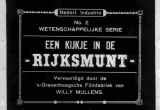Folklorism – Before It’s Too Late
The idea that progress was unstoppable wasn’t new. It had already been around for about a century in the days of folklorist Dirk Jan van der Ven. Although the 19th century was characterised by industrialisation and optimism about civilisation’s advances, there was a growing countermovement that idealised the past and nature and saw this ‘civilisation’ as the source of all human suffering.
Rapid changes
While in the 18th century the interest in the past as an Arcadian era was often limited to the study of classical antiquity and painting, that shifted in the 19th century. Change was happening more rapidly: cities grew explosively and in some places, factory smokestacks and constantly smoggy air dominated the horizon.
The Dutch countryside, which had almost no paved roads up until that time, was crossed by railways starting in 1838; after that, the steam tram companies began to open up these sparsely populated areas. By the start of the 20th century, the telephone was being adopted steadily, the first automobiles appeared and more and more people were connected to gas from city gasworks, or had installed electricity in their homes.
All of this progress came at a price – traditions were surrendered, and the landscape was sacrificed. Slowly a consensus was reached that there was a Dutch national heritage and that it should be studied and preserved. These ideas took shape with the establishment of institutions such as the Koninklijke Nederlandse Natuurhistorische Vereniging in 1901, the Vereniging tot Behoud van Natuurmonumenten in 1905 and the Bond Heemschut in 1911. Each of these organisations shared the wish to spare parts of the Netherlands from progress.
That interest in nature – as far as the Dutch cultivated landscape of pastures, heathlands, a few forests and lots of water could be called natural – was also extended to the land’s inhabitants. In those days, the folkorists declared that modernity was starting to get its clutches on rural communities, and most often, they concluded that this was a terrible thing.
Everyone has an opinion
There had been a steady decline in people wearing traditional dress, and almost everyone had an opinion about this. Even the local tourist boards chimed in – as if tourism were a part of the traditional rural life – saying it would be nicer for visitors if the locals would walk around in their traditional costumes.
Despite all this, it slowly started to become clear that increased mobility meant that people would slowly start to change to keep up with the times, no matter where they lived.
As things should have been
The reaction to this reality is logical: people wanted disappearing customs to be preserved for future generations. The establishment of the Openluchtmuseum (‘Open Air Museum’) and the production of folkloristic films fit within this development.
However, there must have been many times when historians and folklorists concluded that certain customs were already ‘extinct’, or that some parts of history were less appealing than was supposed. At this stage, nostalgia sometimes won out over fact: Van der Ven clearly made reality look better than it was in different parts of his work, and sometimes showed folklore not as it was, but how it should have been – according to him.
more information
If you are looking for more material from our collection, please contact Film Sales:
sales@eyefilm.nl
phone +31 (0)20 5891 426
